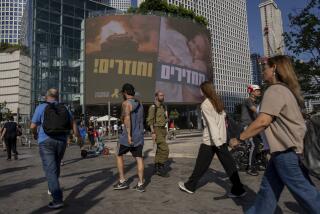Flow of Displaced Eritreans Grows as War Continues
- Share via
ADI KEIH, Eritrea — As the pounding of shells echoed from beyond nearby mountain ranges and smoke issued from above, a stream of humanity flowed Saturday along the asphalt road out of this rocky hillside town and north toward the nation’s capital, Asmara.
Old men, women and children carrying bundles of their meager belongings tied in cloths across their backs trudged limply along in the sweltering heat, as truckloads of Eritrean troops rumbled by them toward the direction of the booming mortars.
Eritrean officials said advancing Ethiopian forces were shelling in the vicinity of Senafe, just 15 miles south of Adi Keih. Senafe, population 106,000, was among three towns that fell to the Ethiopians on Friday.
“The war is now in Senafe,” Tesfai Vaesi, the town’s administrator, told reporters in Adi Keih. “We did not tell the people to leave, but they were afraid of the planes and shelling.”
The wave of refugees became the latest victims of a two-year war over disputed territory along a 620-mile border that has turned allies into enemies. Eritrea gained its independence from Ethiopia in 1993.
Since the latest outbreak of fighting between Ethiopia and Eritrea began May 12, tens of thousands of Eritrean civilians have fled or been evacuated from their homes.
Local officials, who estimate that the country has more than half a million internally displaced people as a result of the conflict, warned that a humanitarian catastrophe was in the making.
“We are facing a big difficulty,” said Yemane Gebremeskel, an Eritrean presidential advisor. “Unless we are able to reverse the military situation and have peace, it will have a long-term impact on Eritrea.”
Although both sides have agreed to resume indirect peace talks Monday in Algiers, Ethiopia has refused to quit fighting, stating that the war would not end until it had “incapacitated” Eritrea’s army.
“We will negotiate, and negotiate in good faith,” Ethiopian Prime Minister Meles Zenawi said last week. “But we will not cease fire until one thing happens--until the jackboots of the invader are removed from our territory, until the invasion is reversed lock, stock and barrel.”
Eritrea on Saturday called on the U.N. Security Council to pass an urgent resolution urging Ethiopia to halt its offensive in Eritrean territory.
“Ethiopia is playing a child’s game,” Gebremeskel said. “The international community has the responsibility to say the game is not accepted.”
“The Ethiopian objective is to bring the Eritrean government down, to crash the Eritrean economy and to turn Eritrea into a new Somalia,” said Eritrean presidential advisor Yemane Gebreab.
Ethiopian Forces Claim Success
While hundreds of Ethiopian soldiers continued to celebrate their capture of the key town of Zalambessa last week, fellow troops claimed to have already seized Adi Keih.
Meanwhile, residents from towns falling under Ethiopian occupation have taken to the streets of this parched and rugged landscape in search of shelter and safety.
“We are afraid of the shelling, and after that it could be the planes coming,” said Rahama Mahamed, 50, a native of Adi Keih, who was leaving behind her shop and fleeing with her three young children. “We are trying to find cars to go to my parents in Asmara.”
Many refugees had bundled their possessions atop donkeys and camels. Some appealed to passersby with vehicles to take their children along, while others huddled under the shade of rocks to escape the blistering sun.
Displaced Seek Refuge in Camps and in Sudan
Tears gushed from Mekdes Beluts’ eyes as the 30-year-old woman--who was born and raised in the Ethiopian capital, Addis Ababa--related how the outbreak of the war in May 1998 forced her to become a refugee in Eritrea, a land she hardly knew.
“I don’t have family here,” said Beluts, clutching a plastic container with water, her sole source of energy for several hours. “I don’t have money. I don’t have anything.”
More than 500,000 people, an eighth of Eritrea’s population, have congregated in poorly equipped camps for the displaced, and 100,000 have fled across the western border into Sudan, aid officials said.
Already on the brink of famine after a prolonged drought, Eritrea is struggling to feed this new group of needy, more than half of whom are children. Officials from the state-run Eritrean Relief and Refugee Commission, or ERRC, said rations of grain and water, trucked in from the capital, would soon run out. They argued that the responsibility for Eritrea’s predicament rested solely with Ethiopia.
“Who else can we blame?” asked Worku Tesfamichael, the commissioner for ERRC. “The border conflict should not have escalated to this type of fully fledged war. It could have been solved through negotiation.”
Many Eritreans believe that the international community has favored Ethiopia in its distribution of humanitarian assistance and neglected Eritrea.
It “has chosen to watch thousands of people dying,” Gebreab said. “The Security Council has refused to lift a finger.”
Despite their suffering, many Eritrean civilians remain defiant in their resolve to stand up to Ethiopia’s wrath.
“Even if the [Ethiopian] army comes, I will never leave my house,” said Yohannas Maharuf, 73, a father of nine children, three of whom are fighting at the front.
The former farmer, who lived in Ethiopia for 30 years, said he supported his government’s decision to challenge Ethiopia’s aggression.
“We are happy with what our government is doing,” Maharuf said. It “is fighting for our land. All Eritreans . . . we are of one heart.”
*
Times staff writer John-Thor Dahlburg in Addis Ababa contributed to this report.
More to Read
Sign up for Essential California
The most important California stories and recommendations in your inbox every morning.
You may occasionally receive promotional content from the Los Angeles Times.










